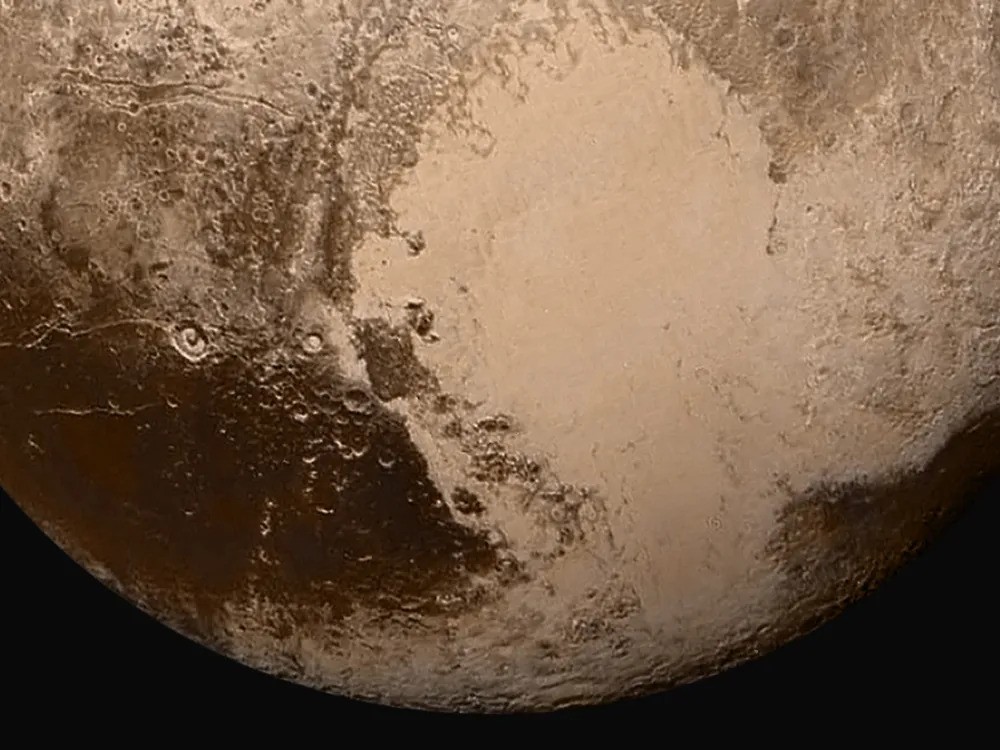On the dwarf planet Pluto, there is an amazing formation known as the Tombaugh Regio. It has the shape of a heart. Scientists have recently established that the cause of its formation was a collision with some kind of body that occurred tangentially.

Icy Heart of Pluto
The mystery of how a giant ice-like heart appeared on the surface of Pluto has finally been solved by an international team of astrophysicists led by the University of Bern and members of the National Center for Competence in Research (NCCR) PlanetS. For the first time, the team successfully recreated its unusual shape using numerical modeling, explaining it by a giant and rather slow impact at an acute angle.
Since the cameras of NASA’s New Horizons mission discovered a large heart-shaped structure on the surface of the dwarf planet Pluto in 2015, it has constantly puzzled scientists with its unique shape, geological composition and height. A team of scientists from the University of Bern, along with several members of NCCR PlanetS, and staff from the University of Arizona in Tucson used numerical modeling to investigate the origin of Sputnik Planitia, the western teardrop-shaped part of Pluto’s heart-shaped surface.
According to their research, the early history of Pluto was marked by a cataclysm, which resulted in the formation of Sputnik Planitia: a collision with a planetary body with a diameter of about 700 km, which is about twice the size of Switzerland from east to west. The team’s findings, recently published in the journal Nature Astronomy, also suggest that Pluto’s internal structure differs from what was previously thought, which means that there is no underground ocean on it.
Tangential collision
The icy heart of Pluto does not consist of a single element. Sputnik Planitia, which is its western part, covers an area of 1,200 by 2,000 kilometers, which is equivalent to a quarter of Europe or the United States. It is impressive that this region is three to four kilometers lower in altitude than most of the surface of Pluto. The eastern part of the heart is also covered with a similar, but much thinner layer of nitrogen ice, the origin of which is still unclear to scientists, but probably related to the geological structure.
“The elongated shape of Sputnik Planitia strongly suggests that the impact was not a direct head-on collision but rather an oblique one,” notes Dr. Martin Jutzi from the University of Bern, who initiated the study.
His team, like several others from around the world, used their smoothed particle hydrodynamics (SPH) simulation software to digitally reproduce such collisions, changing both the composition of Pluto and the body that collided with it, as well as the velocity and angle of the collision. These simulations confirmed scientists’ suspicions about a collision at an acute collision angle and determined the composition of the impact body.
Pluto’s core is so cold that the rocks remained very hard and did not melt despite the heat from the impact. In addition, due to its angle and low velocity, the impactor core did not sink into the planet, but fell to its surface in the form of debris.
There is no underground ocean on Pluto
The current study also revealed something about the internal structure of Pluto. In fact, a giant impact like the one modeled is much more likely than the one that occurred at a very early stage in Pluto’s history. However, this creates a problem: a giant depression like Sputnik Planitia, according to the laws of physics, should slowly move towards the pole of a dwarf planet over time, since it has a mass deficit. However, it is paradoxically located near the equator.
The previous theoretical explanation was that Pluto, like several other planetary bodies in the outer Solar System, has a subsurface ocean of liquid water. According to this preliminary explanation, Pluto’s icy crust would have been thinner in the Sputnik Planitia area, which would have led to ocean bulging, and since liquid water is denser than ice, an excess mass would have formed as a result, which would have caused migration to the equator.
However, the new study offers an alternative perspective. “In our simulations, all of Pluto’s primordial mantle is excavated by the impact, and as the impactor’s core material splats onto Pluto’s core, it creates a local mass excess that can explain the migration toward the equator without a subsurface ocean, or at most a very thin one,” explains Martin Jutzi.
Dr. Adeene Denton of the University of Arizona, who is also a co-author of the study, is now conducting a new research project to assess the speed of this migration. “This novel and inventive origin for Pluto’s heart-shaped feature may lead to a better understanding of Pluto’s origin,” she concludes.
According to phys.org
Follow us on Twitter to get the most interesting space news in time
https://twitter.com/ust_magazine


